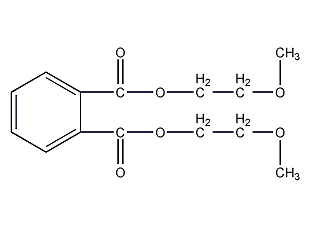
Structural formula
| Business number | 039A |
|---|---|
| Molecular formula | C14H18O6 |
| Molecular weight | 282.29 |
| label |
Plasticizer DMEP, plasticizer DMEP, dimethoxyethyl phthalate, Bis(2-methoxyethyl) phthalate, Dimethylglycol phthalate, plasticizer, Adhesive |
Numbering system
CAS number:117-82-8
MDL number:MFCD00042842
EINECS number:204-212-6
RTECS number:TI1400000
BRN number:2056929
PubChem number:24862960
Physical property data
1. Properties: light yellow oily liquid
2. Density (g/mL, 20℃): 1.170-1.176
3. Relative vapor density (g/mL, Air = 1): Undetermined
4. Melting point (ºC): -40
5. Boiling point (ºC, normal pressure): 350
6. Boiling point (ºC, KPa): Not determined
7. Refractive index: 1.503
8. Flash point (ºC): 185
9. Specific rotation (º): Not determined
10. Autoignition point or ignition temperature (ºC): Not determined
11. Vapor pressure (mmHg, ºC): Not determined
12. Saturated vapor pressure (kPa, ºC): Undetermined
13. Heat of combustion (KJ/mol): Undetermined
14. Critical temperature (ºC): Undetermined
15. Critical pressure (KPa): Undetermined
16. Log value of oil-water (octanol/water) partition coefficient: Undetermined
17. Explosion upper limit (%, V/V): Undetermined
18. Explosion lower limit (%, V/V): Undetermined
19. Solubility: Incompatible with alcohol It is miscible with various organic solvents such as acetone, petroleum ether and oil, and is slightly soluble in glycerol and ethylene glycol.
20. Color (APHA): <50
21. Evaporation rate: 0.0041g/1000cm2·h (100℃)
Toxicological data
1. Irritation: Guinea pig transdermal: 500mg/24 hours, mild irritation. Rabbit eye: 100mg, mild irritation.
2. Acute toxicity:
Oral LD5O in mice: 3200mg/kg; Oral LD5O in rats: 2750mg/kg; Dermal LD5O in guinea pigs: >20g/kg; Large Rat inhalation LCLO: 1595ppm/6H
Ecological data
Slightly harmful to water.
Molecular structure data
1. Molar refractive index: 71.82
2. Molar volume (cm3/mol): 243.9
3. Isotonic specific volume (90.2K ): 615.4
4. Surface tension (dyne/cm): 40.4
5. Polarizability (10-24cm3): 28.47
Compute chemical data
1. Reference value for hydrophobic parameter calculation (XlogP): None
2. Number of hydrogen bond donors: 0
3. Number of hydrogen bond acceptors: 6
4. Number of rotatable chemical bonds: 10
5. Number of tautomers: none
6. Topological molecule polar surface area 71.1
7.Number of heavy atoms:20
8. Surface charge: 0
9. Complexity: 274
10. Number of isotope atoms: 0
11. Determine the number of atomic stereocenters: 0
12. Uncertain number of atomic stereocenters: 0
13. Determine the number of chemical bond stereocenters: 0
14. Number of uncertain chemical bond stereocenters: 0
15. Number of covalent bond units: 1
Properties and stability
Stable at room temperature and pressure, avoid contact with strong oxidants.
Storage method
Stored in a cool, ventilated warehouse. Keep away from fire and water sources. should be kept away from oxidizer, do not store together. Equipped with the appropriate variety and quantity of fire equipment. Suitable materials should be available in the storage area to contain spills.
Synthesis method
Methoxyethanol is obtained by performing an addition reaction between ethylene oxide, methanol, and boron trifluoride ether, and neutralizing the reaction product. Then carry out esterification reaction with phthalic anhydride, and then use activated carbon to decolorize, distill, water wash, alkali wash, dehydration, and press filtration to obtain the finished product. After the esterification reaction product is washed with water, it is distilled under reduced pressure. This post-treatment process is also used in industrial production. The DMEP content of industrial products is ≥99. Raw material consumption quota: phthalic anhydride 750kg/t, ethylene oxide 820kg/t, methanol 660kg/t.

Purpose
It is mainly used as a plasticizer for cellulose acetate. It is less volatile than diethyl phthalate, has good durability, and makes the film tough. It can be used in enameled wires, film films, high-strength varnishes, adhesives and laminate adhesives, etc.; it can also be used as sensitizer and solvent for gas chromatography fixatives and triacetic acid film bases. It can be used as a plasticizer for cellulose resin, vinyl resin, and synthetic rubber. It is less volatile than diethyl phthalate (DEP) and can give products good durability, toughness, and oil resistance. It is mainly used as a plasticizer for cellulose acetate in the manufacture of enameled wires, film films, high-strength varnishes, adhesives and laminate adhesives.



 微信扫一扫打赏
微信扫一扫打赏
